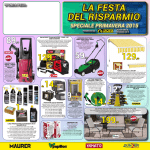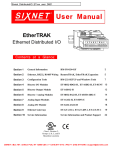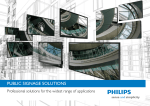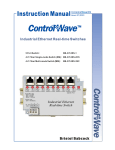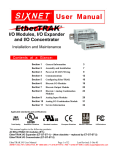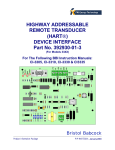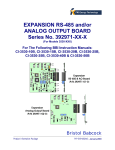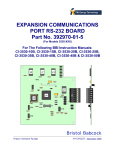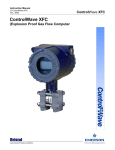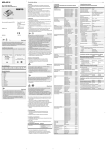Download Bristol ControlWave Ethernet Distributed (Remote) I/O Modules (CI
Transcript
Instruction Manual CI-ControlWave Wave RI/O Issue: 08/2001 TM Ethernet Distributed (Remote) I/O MODULES Discrete I/O Modules: BB-8DI2-8DO2-H, BB-16DI2-H & BB-8CNT Discrete Output Modules: BB-16DO2-H Discrete / Analog Modules: BB-8DI2-8AI2-H & BB-4RTD-4DI2-U Analog Input Modules: BB-16AI2-H & BB-8INS-U Analog I/O Modules: BB-8AI2-4AO2-H ControlWave ControlWave Ethernet I/O Bristol Babcock NOTICE Copyright Notice The information in this document is subject to change without notice. Every effort has been made to supply complete and accurate information. However, Bristol Babcock assumes no responsibility for any errors that may appear in this document. Request for Additional Instructions Additional copies of instruction manuals may be ordered from the address below per attention of the Sales Order Processing Department. List the instruction book numbers or give complete model number, serial or software version number. Furnish a return address that includes the name of the person who will receive the material. Billing for extra copies will be according to current pricing schedules. ControlWaveTM is a trademark of Bristol Babcock. Other trademarks or copy-righted products mentioned in this document are for information only, and belong to their respective companies, or trademark holders. Copyright (c) 2001 Bristol Babcock, 1100 Buckingham St., Watertown, CT 06795. No part of this manual may be reproduced in any form without the express written permission of Bristol Babcock. IMPORTANT! READ INSTRUCTIONS BEFORE STARTING! Be sure that these instructions are carefully read and understood before any operation is attempted. Improper use of this device in some applications may result in damage or injury. The user is urged to keep this book filed in a convenient location for future reference. These instructions may not cover all details or variations in equipment or cover every possible situation to be met in connection with installation, operation or maintenance. Should problems arise that are not covered sufficiently in the text, the purchaser is advised to contact Bristol Babcock for further information. EQUIPMENT APPLICATION WARNING The customer should note that a failure of this instrument or system, for whatever reason, may leave an operating process without protection. Depending upon the application, this could result in possible damage to property or injury to persons. It is suggested that the purchaser review the need for additional backup equipment or provide alternate means of protection such as alarm devices, output limiting, fail-safe valves, relief valves, emergency shutoffs, emergency switches, etc. If additional information is required, the purchaser is advised to contact Bristol Babcock. RETURNED EQUIPMENT WARNING When returning any equipment to Bristol Babcock for repairs or evaluation, please note the following: The party sending such materials is responsible to ensure that the materials returned to Bristol Babcock are clean to safe levels, as such levels are defined and/or determined by applicable federal, state and/or local law regulations or codes. Such party agrees to indemnify Bristol Babcock and save Bristol Babcock harmless from any liability or damage which Bristol Babcock may incur or suffer due to such party's failure to so act. ELECTRICAL GROUNDING Metal enclosures and exposed metal parts of electrical instruments must be grounded in accordance with OSHA rules and regulations pertaining to "Design Safety Standards for Electrical Systems," 29 CFR, Part 1910, Subpart S, dated: April 16, 1981 (OSHA rulings are in agreement with the National Electrical Code). The grounding requirement is also applicable to mechanical or pneumatic instruments that include electrically-operated devices such as lights, switches, relays, alarms, or chart drives. EQUIPMENT DAMAGE FROM ELECTROSTATIC DISCHARGE VOLTAGE This product contains sensitive electronic components that can be damaged by exposure to an electrostatic discharge (ESD) voltage. Depending on the magnitude and duration of the ESD, this can result in erratic operation or complete failure of the equipment. Bristol Babcock 1100 Buckingham Street, Watertown, CT 06795 Telephone (860) 945-2200 WARRANTY A. Bristol warrants that goods described herein and manufactured by Bristol are free from defects in material and workmanship for one year from the date of shipment unless otherwise agreed to by Bristol in writing. B. Bristol warrants that goods repaired by it pursuant to the warranty are free from defects in material and workmanship for a period to the end of the original warranty or ninety (90) days from the date of delivery of repaired goods, whichever is longer. C. Warranties on goods sold by, but not manufactured by Bristol are expressly limited to the terms of the warranties given by the manufacturer of such goods. D. All warranties are terminated in the event that the goods or systems or any part thereof are (i) misused, abused or otherwise damaged, (ii) repaired, altered or modified without Bristol's consent, (iii) not installed, maintained and operated in strict compliance with instructions furnished by Bristol, or (iv) worn, injured or damaged from abnormal or abusive use in service time. E. THESE WARRANTIES ARE EXPRESSLY IN LIEU OF ALL OTHER WARRANTIES EXPRESS OR IMPLIED (INCLUDING WITHOUT LIMITATION WARRANTIES AS TO MERCHANTABILITY AND FITNESS FOR A PARTICULAR PURPOSE), AND NO WARRANTIES, EXPRESS OR IMPLIED, NOR ANY REPRESENTATIONS, PROMISES, OR STATEMENTS HAVE BEEN MADE BY BRISTOL UNLESS ENDORSED HEREIN IN WRITING. FURTHER, THERE ARE NO WARRANTIES WHICH EXTEND BEYOND THE DESCRIPTION OF THE FACE HEREOF. F. No agent of Bristol is authorized to assume any liability for it or to make any written or oral warranties beyond those set forth herein. REMEDIES A. Buyer's sole remedy for breach of any warranty is limited exclusively to repair or replacement without cost to Buyer of any goods or parts found by Seller to be defective if Buyer notifies Bristol in writing of the alleged defect within ten (10) days of discovery of the alleged defect and within the warranty period stated above, and if the Buyer returns such goods to Bristol's Watertown office, unless Bristol's Watertown office designates a different location, transportation prepaid, within thirty (30) days of the sending of such notification and which upon examination by Bristol proves to be defective in material and workmanship. Bristol is not responsible for any costs of removal, dismantling or reinstallation of allegedly defective or defective goods. If a Buyer does not wish to ship the product back to Bristol, the Buyer can arrange to have a Bristol service person come to the site. The Service person's transportation time and expenses will be for the account of the Buyer. However, labor for warranty work during normal working hours is not chargeable. B. Under no circumstances will Bristol be liable for incidental or consequential damages resulting from breach of any agreement relating to items included in this quotation from use of the information herein or from the purchase or use by Buyer, its employees or other parties of goods sold under said agreement. How to return material for Repair or Exchange Before a product can be returned to Bristol Babcock for repair, upgrade, exchange, or to verify proper operation, form (GBU 13.01) must be completed in order to obtain a RA (Return Authorization) number and thus ensure an optimal lead time. Completing the form is very important since the information permits the Bristol Babcock Repair Dept. to effectively and efficiently process the repair order. You can easily obtain a RA number by: A. FAX Completing the form (GBU 13.01) and faxing it to (860) 945-3875. A BBI Repair Dept. representative will return call (or other requested method) with a RA number. B. E-MAIL Accessing the form (GBU 13.01) via the Bristol Babcock Web site (www.bristolbabcock.com) and sending it via E-Mail to [email protected]. A BBI Repair Dept. representative will return E-Mail (or other requested method) with a RA number. C. Mail Mail the form (GBU 13.01) to Bristol Babcock Inc. Repair Dept. 1100 Buckingham Street Watertown, CT 06795 A BBI Repair Dept. representative will return call (or other requested method) with a RA number. D. Phone Calling the BBI Repair Department at (860) 945-2442. A BBI Repair Department representative will record a RA number on the form and complete Part I, then send the form to the Customer via fax (or other requested method) for Customer completion of Parts II & III. A copy of the completed Repair Authorization Form with issued RA number should be included with the product being returned. This will allow us to quickly track, repair, and return your product to you. Bristol Babcock Inc. Repair Authorization Form (Providing this information will permit BBI to effectively and efficiently process your return. Completion is required to receive optimal lead time. Lack of information may result in increased lead times.) Date___________________ RA #___________________SH_ Standard Repair Practice is as follows: Variations to this is practice may be requested in the “Special Requests” section. • Evaluate / Test / Verify Discrepancy • Repair / Replace / etc. in accordance with this form • Return to Customer Part I Line No.____________ Please be aware of the Non warranty standard charge: • There is a $100 minimum evaluation charge, which is applied to the repair if applicable (√ in “returned” B,C, or D of part III below) Please complete the following information for single unit or multiple unit returns Address No. (office use only) Address No. (office use only) Bill to : Ship to: Purchase Order: Contact Name:____________________________________ Phone: Fax: Part II E-Mail: Please complete Parts II & III for each unit returned Model No./Part No. Description Range/Calibration S/N Reason for return : 1. Failure Upgrade Verify Operation Other Describe the conditions of the failure (Frequency/Intermittent, Physical Damage, Environmental Conditions, Communication, CPU watchdog, etc.) (Attach a separate sheet if necessary) 2. Comm. interface used: 3. What is the Firmware revision? _____________________ Standalone RS-485 Ethernet Other:______________ Modem (PLM (2W or 4W) or SNW) What is the Software &version? Part III If checking “replaced” for any question below, check an alternate option if replacement is not available A. If product is within the warranty time period but is excluded due to BBI’s warranty clause, would you like the product: repaired returned replaced scrapped? B. If product were found to exceed the warranty period, would you like the product: repaired returned replaced scrapped? C. If product is deemed not repairable would you like your product: returned replaced scrapped? D. If BBI is unable to verify the discrepancy, would you like the product: returned replaced *see below? * Continue investigating by contacting the customer to learn more about the problem experienced? The person to contact that has the most knowledge of the problem is: _______________________________ phone If we are unable to contact this person the backup person is: _________________________ phone Special Requests: Ship prepaid to: Bristol Babcock Inc., Repair Dept., 1100 Buckingham Street, Watertown, CT 06795 Phone: 860-945-2442 Fax: 860-945-3875 Form GBU 13.01 Rev. A Bristol Babcock Training GET THE MOST FROM YOUR BRISTOL BABCOCK INSTRUMENT OR SYSTEM ● Avoid Delays and problems in getting your system on-line ● Minimize installation, start-up and maintenance costs. ● Make the most effective use of our hardware and software. ● Know your system. As you know, a well-trained staff is essential to your operation. Bristol Babcock offers a full schedule of classes conducted by full-time, professional instructors. Classes are offered throughout the year at four locations: Houston, Birmingham, Orlando and our Watertown, CT headquarters. By participating in our training, your personnel can learn how to install, calibrate, configure, program and maintain any and all Bristol Babcock products and realize the full potential of your system. For information or to enroll in any class, contact our training department in Watertown at (860) 945-2269. For Houston classes, you can also contact our Houston office, at (713) 6856200. BLANK PAGE A Few Words About Bristol Babcock For over 100 years, Bristol7 has been providing innovative solutions for the measurement and control industry. Our product lines range from simple analog chart recorders, to sophisticated digital remote process controllers and flow computers, all the way to turnkey SCADA systems. Over the years, we have become a leading supplier to the electronic gas measurement, water purification, and wastewater treatment industries. On off-shore oil platforms, on natural gas pipelines, and maybe even at your local water company, there are Bristol Babcock instruments, controllers, and systems running year-in and year-out to provide accurate and timely data to our customers. Getting Additional Information In addition to the information contained in this manual, you may receive additional assistance in using this product from the following sources: Contacting Bristol Babcock Directly Bristol Babcock's world headquarters are located at 1100 Buckingham Street, Watertown, Connecticut 06795, U.S.A. Our main phone numbers are: (860) 945-2200 (860) 945-2213 (FAX) Regular office hours are Monday through Friday, 8:00AM to 4:30PM Eastern Time, excluding holidays and scheduled factory shutdowns. During other hours, callers may leave messages using Bristol's voice mail system. Telephone Support - Technical Questions During regular business hours, Bristol Babcock's Application Support Group can provide telephone support for your technical questions. For technical questions about TeleFlowÔ products call (860) 945-8604. For technical questions about ControlWave call (860) 945-2244 or (860) 945-2286. For technical questions regarding Bristol’s OpenEnterprise product, call (860) 945-2501 or e-mail: [email protected] For technical questions regarding ACCOL products, Open BSI Utilities, as well as Bristol's Enterprise Server7/Enterprise Workstation7 products, call (860) 945-2286. For technical questions about Network 3000 hardware, call (860) 945-2502. You can e-mail the Application Support Group at: [email protected] The Application Support Group also maintains a service area within our main web site. Technical information, as well as software updates are available in this area. To access our web site, go to: bristolbabcock.com/services/techsupport/ For assistance in interfacing Bristol Babcock hardware to radios, contact Communication Technologies in Orlando, FL at (407) 629-9463 or (407) 629-9464. Telephone Support - Non-Technical Questions, Product Orders, etc. Questions of a non-technical nature (product orders, literature requests, price and delivery information, etc.) should be directed to the nearest sales office (listed below) or to your Bristol-authorized sales representative. Major U.S. Sales Offices Major International Sales Offices: Watertown, CT (860) 945-2262 Birmingham, AL (205) 980-2010 Ontario, CA (909) 923-8488 Farmington, NM (505) 327-3271 Houston, TX (713) 685-6200 Richardson, TX (972) 238-8935 Bristol Babcock Ltd (UK): (441) 562-820-001 Bristol of Canada: (416) 675-3820 Bristol Babcock Asia Pacific 61 8-9455-9955 BBI, S.A. de C.V. (Mexico) (525) 254-2131 Please call the main Bristol Babcock number (860-945-2200) if you are unsure which office covers your particular area. Visit our Site on the World Wide Web For general information about Bristol Babcock and its products, please visit our site on the World Wide Web at: www.bristolbabcock.com Instruction Manual ControlWave Ethernet Distributed (Remote) I/O Modules ControlWave Ethernet I/O Contents at a Glance: Section 1 General Information Ethernet I/O modules 2 Section 2 Ethernet and RS485 Wiring Remote I/O, Ethernet I/O Expansion 3 Section 3 Configuration Tools BB-232-SETUP and Windows Tools 4 Section 4 Discrete I/O Modules BB-8DI2-8DO2-H, BB-16DI2-H, BB-8CNT 7 Section 5 Discrete Output Module BB-16DO2-H 10 Section 6 Discrete / Analog Modules BB-8DI2-8AI2-H, BB-4RTD-4DI2-U 11 Section 7 Analog Input Modules BB-16AI2-H, BB-8INS-U 13 Section 8 Analog I/O Module BB-8AI2-4AO2-H 15 Section 9 Modbus Communications Scheme Configuration Notes 16 Supplements & Appendices Special Instructions for Class I, Division 2 Hazardous Locations ......................... Appendix A Class I, Division 2, Groups A, B, C, and D Hazardous Locations CI-ControlWaveRI/O Table Of Contents 1 Section 1 General Information Overview This manual will help you install and maintain Ethernet Remote I/O Modules and gateways. In summary, wiring for power, communications and I/O is connected to each module’s base. Then, setup choices are entered using the Remote I/O Tool Kit software and the system will be ready to run. Shown below are some typical system configurations using Ethernet I/O: Ethernet Hub RS 485 ControlWave Ethernet I/O ControlWave Ethernet I/O ControlWave Ethernet I/O Distributed Ethernet and serial I/O General Specifications These general specifications apply to all Ethernet I/O modules. More detailed product specifications may be found in the online help system of the Remote I/O Toolkit configuration utility. Supply Voltage Section 1 RS485 Expansion 10 - 30 Vdc, 1.2 Watt typical per module (48 mA @ 24 Vdc - varies by module and load). Connect up to 32 Remote I/O modules using RS485 Ethernet Isolation Operating Temperature Storage Temperature Humidity 1200 Volts RMS (for 1 minute) -30 to 70 °C -40 to 85 °C 5 to 95% (non-condensing) Protocols Supported Open Modbus/TCP, Serial Modbus RTU & ASCII Universal General Information 2 Section 2 Ethernet and RS485 Wiring DC Power Overview Ethernet I/O modules can be powered from the same DC source that is used to power your I/O devices. No separate power supply is required. Typically, 10 to 30 VDC power is applied to terminals 24 and 25 on the base of each module. Refer to the upcoming wiring diagram for each module for power connections. RS485 Wiring Guidelines The RS485 party-line consists of two wires and an isolated ground wire. It is recommended that the ground wire be connected to all stations to provide a common return. The RS485 port on all Ethernet I/O modules is isolated from its internal circuitry, local power source, and I/O wiring to improve communications reliability. It is recommended that only 32 Remote I/O modules be connected on any RS485 party-line, and that the termination jumper be installed on the last module on each end of the RS485 network. Limiting the cabling to two network arms (segments) radiating from the master controller will yield the best signal results. Screw Torque Section 2 19 20 21 22 23 G + - T1 T2 19 20 21 22 23 G + - T1 T2 19 20 21 22 23 G + - T1 T2 First Node Middle Node End Node All the screw terminals on the base should be tightened to a maximum of 3.48 in-lbs. Ethernet and RS485 Wiring 3 Section 3 Configuration Tools BB-232-SETUP Remote I/O Setup Module Operation This setup tool is recommended to initially configure each Ethernet Remote I/O module. To use the setup module, simply unplug any Ethernet I/O module from its base and insert the setup module into the base. Note: Ethernet I/O “smart bases” allow hot swap of live modules -- an exclusive feature that makes it permissible to configure Ethernet I/O modules in live systems. The Ethernet I/O module configuration you created using the Remote I/O Tool Kit program will be written into permanent memory in the module’s base. When the Ethernet I/O module is reinserted into its base, the module will find and upload the configuration information, instantly configure itself and begin scanning I/O. Once an Ethernet I/O module has been configured with an appropriate station address and IP address (Ethernet I/O only), modified configuration data can be downloaded through the Ethernet port or RS485 port into the module base. More information on the Remote I/O Setup Module can be found in the online help system of the Remote I/O Toolkit. RS232 Wiring Connect the setup module to your Windows PC using a standard BB ST-CABLE-PF RS232 cable. Only the transmit (TD), receive (RD) and common return (GND) signals are actively used. The RS232 port on this configuration tool is electrically isolated to protect your computer in the event of field wiring errors. The setup module runs on the DC power connected to terminals 17 and 18 of the module base it is plugged into. No other connections are required. (I/O wiring can be left undisturbed.) RS232 Mode Selection This module always communicates to the host PC at 9600 baud, with no parity and eight data bits. Be sure to select “Use Setup Module’s Settings” as the communication device selection in the Remote I/O Tool Kit program. Section 3 Configuration Tools 4 Remote I/O Tool Kit Ethernet I/O modules are configured using the Remote I/O Tool Kit software. Configuration parameters are written over Ethernet, RS485 or RS232 (setup module only) into permanent memory in the module’s base. Refer to the Remote I/O Tool Kit help for details. Here are the basic steps for configuring an Ethernet I/O module. 1. Connect DC power to the module. 2. Connect an Ethernet cable to the module. Use a straight-through cable if you are connecting to an Ethernet hub or switch. Use a cross-wired cable if you are connecting directly to a PC. Make sure the LNK LED on the module is on solid (not blinking). 3. Run the Remote I/O Tool Kit. You can use the Plug & Play Wizard to define the parameters for the module. Be sure to do the following: • Choose an IP address that is appropriate for your network. See the help file for details. • Enter in the serial number that is printed on a label on the module. • Choose a station (slave) number for the module. This number must be unique from other modules and the device to which you are interfacing. • Select the appropriate RS232 or RS485 com parameters (protocol, baud rate, etc.) to match the device to which you are interfacing. 4. Once you’ve completed the wizard, save your project file. Go to the Device menu and choose the appropriate communication device. Then go to the Operations menu and select Load. This should set the IP address in the module and then load down your other parameters. If this load fails for some reason, here are some items to check: • Make sure the LNK LED is on solid. If it is off or blinking then a typical cause is a bad cable, an incorrect cable, or you are plugged into the wrong port on your hub/switch. • Try to “ping” the module. Ping is a utility that comes with your PC. Start an MSDOS prompt and type “ping” followed by the IP address of the gateway and then hit <CR>. For example, “ping 10.1.0.1” (do not type the quotes). If you get an “unknown command” error then you will need to install the TCP/IP Ethernet protocol on your computer. If you get “destination unreachable” then make sure the gateway’s IP address is valid with respect to the IP address and subnet mask of your computer. If you get “request timeout” then check all the items above. Note: Information on Ethernet networking can be found in the online help system for the Remote I/O Toolkit. 5. Section 3 Once you establish that you can communicate with the module from the Remote I/O Tool Kit you then should attempt to communicate with your device using your ControlWave master. Configuration Tools 5 Ethernet I/O LEDs Every Ethernet I/O module has a number of LEDs. These LEDs can be useful for system diagnostics. These LEDs can be observed in the following states: I/O Module Status LED On, with a quick “OFF” BLINK (1.9 seconds ON, .1 seconds OFF) - The module is configured and fully operational, but has not received a valid request from the host for a time longer than the specified time out period. A communication time out has occurred. Full ON - The module is configured, fully operational, and has received communication from the host device before the timeout period expired. This is the desired LED indication during system operation. HALF BLINK (1 second ON, 1 second OFF) - The module is not adequately configured and requires a download from the Remote I/O Tool Kit program. Full OFF - There is no power to the module, or the status LED is being turned off intentionally by the Remote I/O Tool Kit during the module loading operation. Off, with a quick “ON” BLINK (1.9 seconds OFF, .1 seconds ON ) - The module failed self-test at initialization. It will not attempt communication and should be replaced. Status LED Wink Feature The “Status” LED of an I/O module can be intentionally winked (10 blinks/ second) by the Remote I/O Tool Kit program to visually identify the module when other modules are present. ACT / LNK LEDs The activity (ACT) LED on an Ethernet I/O module will flicker anytime there is traffic on the Ethernet network, regardless of whom the network messages are intended for. The link (LNK) LED will be ON whenever a valid link to another Ethernet device is detected. The best troubleshooting tools for Ethernet I/O modules are the Status, ACT, and LNK LEDs on each module. Each Ethernet I/O Status LED indicates the health of the module and also the status of communication from the host device. You can use the Wink feature to provide continuous transmission to an Ethernet I/O. Note that an Ethernet I/O module does not send a reply in response to a Wink command. Section 3 Configuration Tools 6 Section 4 Discrete I/O Modules BB-8DI2-8DO2-H BB-16DI2-H BB-8DI28DO2 Overview 8 Discrete Inputs and 8 Discrete Outputs 16 Discrete Inputs This module provides one terminal for each input or output channel. All inputs may be wired as sourcing or sinking. Outputs are wired in a sourcing (power switching) configuration only. An input count feature uses analog input registers to accumulate the positive transitions of each input. More information may be found in the on-line help in the Remote I/O Tool Kit program. Number of Channels Input Voltage Range Input Current @ 24Vdc Output Voltage Range Maximum Count Rate 8 discrete inputs, 8 discrete outputs (BB-8DI2-8DO2 only) 12/24 VDC/VAC 6.7 mA 10 – 30 VDC 100 Hz (6000 / minute) each input, plus selectable 2KHz (120,000 / minute) mode for input 1 only Wiring and Jumpers One wire from each sourcing field input should be bussed together and connected to terminal 17 (DC +). One wire from each sourcing field output and/or or sinking field input should be bussed together and connected to terminal 18 (DC GND). Refer to the wiring diagram below. Set jumper W1 to match the wiring configuration of the inputs. TPO Feature Time proportioned outputs pulse ON and OFF with a duty cycle proportional to an analog value stored in an analog output register. TPO outputs are a low cost way to get smooth proportional control of heaters and other process variables. Typically, TPO analog output registers are assigned to the output of PID or other control logic in a ACCOL Workbench or ControlWave Designer program. Use the Remote I/O Tool Kit to set pulse cycling as fast as 10 mS or as slow (many minutes) as your system dynamics require. Each output may be configured as a TPO or ordinary discrete output. I/O Registers Function Discrete Inputs Discrete Outputs TPO Values Counter Inputs Section 4 Discrete I/O Modules Module Registers X0 – X7 Y0 – Y7 AY0 – AY7 AX0 – AX7 Modbus Registers 10001 – 10008 00001 – 00008 40001 – 40008 30001 – 30008 7 BB-16DI2-H BB-16DI2 Overview High Density Discrete Input Module This module provides sixteen input channels. Inputs may be wired as all sourcing or sinking. An input count feature uses analog input registers to accumulate the positive transitions of each input. More information on this and other features may be found in the on-line help supplied with the Remote I/O Tool Kit program. Number of Channels Input Voltage Range Input Current @ 24 VDC 16 discrete inputs (connected to a common source) 12/24 VDC/VAC 6.7 mA Wiring and Jumpers Positive DC or AC voltage must be applied to an input to indicate an ON condition. All channels are referenced to a common return or supply, which is connected to the negative side (ground) or positive side (DC+) of the DC power source. One wire from each sourcing field input should be bussed together and connected to terminal 17 (DC +). One wire from each sinking field input should be bussed together and connected to terminal 18 (DC GND). Refer to the wiring diagram below. Set jumper W1 to match the wiring configuration of the inputs. I/O Registers Function Discrete Inputs Counter Inputs Section 4 Discrete I/O Modules Module Registers X0 – X15 AX0 – AX15 Modbus Registers 10001 – 10016 30001 – 30016 8 BB-8CNT BB-8CNT Overview High Speed Counter Module This high-speed counter module has eight isolated circuits that accept pulse inputs from a variety of sources, including quadrature and incremental encoders. Count values are reported in 16 bit analog input registers or 32 bit long registers. The states of the counter inputs are also reported as discrete inputs. Pulse rates up to 50 kHz are supported. The counters may be reset by toggling discrete output bits. Counter modes are selected using the Remote I/O Tool Kit program. More information on this and other features may be found in the on-line help supplied with the Remote I/O Tool Kit program. Number of Channels Input Voltage Range Input Current @ 24 VDC Input Wiring 8 discrete inputs, isolated 12/24 VDC/VAC 6.7 mA Screw terminal assignments are shown below. For best noise immunity, connect input signals using twisted wire pairs. To maintain the best differential noise rejection, do not connect (-) screw terminals together at the I/O base. Positive DC voltage must be applied to an input to indicate an ON condition. Refer to the wiring diagram below. Any odd-numbered input can be gated by connecting a gating signal to the next highest even-numbered input. For example, Input 2 can gate the counter for Input 1. I/O Registers Section 4 Function Discrete Inputs Counter Inputs Module Registers X0 – X7 AX0 – AX7 or LI0 – LI7 Resets Y0 – Y7 Discrete I/O Modules Modbus Registers 10001 – 10008 30001 – 30008 35001 – 35008 00001 – 00008 9 Section 5 Discrete Output Modules BB-16DO2-H BB-16DO2 Overview High Density Discrete Output Module Sixteen discrete output channels each provide up to 1 Amp DC to motor contactors, valves, and other loads. Inductive surge protection is provided. Each of the sixteen outputs may optionally be configured as Time Proportioned Outputs that pulse ON at a duty cycle proportional to an analog output register value. Typically these TPO outputs are controlled by a PID loop or other process algorithm in a control program. More information may be found in the on-line help supplied with the Remote I/O Tool Kit program. Number of Channels Output Voltage Range Max. Load per Output Max. Load per Module Max. Inrush Current 16 discrete outputs connected to a common DC source 10 - 30 VDC 1 Amp 8 Amps 5 Amps (for 100 mS) Wiring A single terminal is provided for each output channel. All outputs are powered from the DC power terminal. All channels are referenced to a common return which is connected to the negative side (ground) of the DC power source. TPO Feature Time proportioned outputs pulse ON and OFF with a duty cycle proportional to an analog value stored in an analog output register. TPO outputs are a low cost way to get smooth proportional control of heaters and other process variables. Typically, TPO analog output registers are assigned to the output of PID or other control logic in a ACCOL Workbench or ControlWave Designer program. Use the Remote I/O Tool Kit to set pulse cycling as fast as 10 mS or as slow (many minutes) as your system dynamics require. Each output may be configured as a TPO or ordinary discrete output. I/O Registers Function Discrete Outputs TPO Values Section 5 Module Registers Y0 – Y15 AY0 – AY15 Discrete Output Module Modbus Registers 00001 – 00016 40001 – 40016 10 Section 6 Discrete / Analog Modules BB-8DI2-8AI2-H BB-8DI2-8AI2 Overview 8 Discrete Inputs and 8 4-20 mA Inputs Eight 4-20 mA inputs provide 14 bit analog measurements. Discrete inputs may be wired as all sourcing or sinking. An input count feature uses analog input registers to accumulate the positive transitions of each input. More information on this and other features may be found in the on-line help supplied with the Remote I/O Tool Kit program. Number of Channels Input Range Analog Input Impedance DI Voltage Range Input Current @ 24 Vdc 8 analog inputs (14 bit resolution), 8 discrete inputs 4 - 20 mA (analog), 12/24 Vdc/Vac (discrete) 100 ohms Note: input voltage drop = 2 volts at 20 mA 12/24 Vdc/Vac 6.7 mA Wiring and Jumpers Positive DC or AC voltage must be applied to an input to indicate an ON condition. All channels are referenced to a common return or supply, which is connected to the negative side (ground) or positive side (DC+) of the DC power source. One wire from each sourcing field input should be bussed together and connected to terminal 17 (DC +). One wire from each sinking field input should be bussed together and connected to terminal 18 (DC GND). Refer to the wiring diagram below. Set jumper W1 to match the wiring configuration of the discrete inputs. A single input terminal is provided for each analog input channel. Care must be taken to externally provide a suitable instrumentation ground for these single ended input circuits. Current Shunts Precision 100 ohm current shunts, beneath the hinged access door in the wiring base, pass current and maintain loop integrity even if the module is unplugged. A spare shunt is provided and may be simply inserted in place of any shunt that open circuits as a result of a current overload. I/O Registers Function Analog Inputs Discrete Inputs Counter Inputs Section 6 Module Registers AX0 – AX7 X0 – X7 AX8 – AX15 Discrete / Analog Modules Modbus Registers 30001 – 30008 10001 – 10008 30009 – 30016 11 BB-4RTD-4DI2-U BB-4RTD4DI2 Overview 4 RTD Inputs and 4 Discrete Inputs Four RTD inputs provide 16 bit high-resolution analog measurements. Discrete inputs may be wired as all sourcing or sinking. An input count feature uses analog input registers to accumulate the positive transitions of each input. More information on this and other features may be found in the on-line help supplied with the Remote I/O Tool Kit program. Number of Channels RTD Input Type / Range Discrete Input Range Input Current @ 24 VDC 4 RTD inputs (16 bit resolution), 4 discrete inputs 100 ohm platinum, -200 to 850 °C 12/24 VDC/VAC 6.7 mA Wiring and Jumpers See the wiring diagram below for RTD inputs. Discrete inputs need positive DC or AC voltage applied to an input to indicate an ON condition. All channels are referenced to a common return or supply, which is connected to the negative side (ground) or positive side (DC+) of the DC power source. One wire from each sourcing field input should be bussed together and connected to terminal 17 (DC +). One wire from each sinking field input should be bussed together and connected to terminal 18 (DC GND). Refer to the wiring diagram below. Set jumper W1 to match the wiring configuration of the discrete inputs I/O Registers Function RTD Inputs Discrete Inputs Counter Inputs Section 6 Module Registers AX0 – AX3 X0 – X3 AX4 – AX7 Discrete / Analog Modules Modbus Registers 30001 – 30004 10001 – 10004 30005 – 30008 12 Section 7 Analog Input Modules BB-16AI2-H BB-16AI2 Overview High Density 4-20 mA Analog Input Module Sixteen 4-20 mA inputs provide 14 bit high-resolution analog measurements. More information may be found in the on-line help supplied with the Remote I/O Tool Kit program. Number of Channels Input Range Input Impedance 16 (14 bit resolution) 4 - 20 mA 100 ohms Note: input voltage drop = 2 volts at 20 mA Wiring A single input terminal is provided for each measurement channel. Care must be taken to externally provide a suitable instrumentation ground for these single ended input circuits. Current Shunts Precision 100 ohm current shunts, beneath the hinged access door in the wiring base, pass current and maintain loop integrity even if the module is unplugged. A spare shunt is provided and may be simply inserted in place of any shunt that open circuits as a result of a current overload. I/O Registers Function Analog Inputs Section 7 Module Registers AX0 – AX15 Analog Input Modules Modbus Registers 30001 – 30016 13 BB-8INS-U BB-8INS Overview Instrumentation Analog Input Module Eight configurable inputs provide 16 bit high-resolution analog measurements. More information may be found in the on-line help supplied with the Remote I/O Tool Kit program. Number of Channels Input Range 8 (16 bit resolution) 0/4 - 20 mA, 62 mV to 10V, JKERTBCNS thermocouples Input Impedance (current) 100 ohms Note: input voltage drop = 2 volts at 20 mA Input Impedance (other ranges) 200K Ohms BB-8INS Wiring Two input terminals are provided for each measurement channel. Channel to channel isolation is provided. 4-20 mA Input Jumpers This module has a 4-20 mA input enable jumper for each channel. Set each jumper to match the desired input as shown in the diagram below. The jumper setting must match the range selection in the Remote I/O Tool Kit. Current Shunts Precision 100 ohm current shunts, beneath the hinged access door in the wiring base, pass current and maintain loop integrity even if the module is unplugged. A spare shunt is provided and may be simply inserted in place of any shunt that open circuits as a result of a current overload. I/O Registers Function Analog Inputs Section 7 Module Registers AX0 – AX7 Analog Input Modules Modbus Registers 30001 – 30008 14 Section 8 Analog I/O Module BB-8AI2-4AO2-H BB-8AI2-4AO2 Overview Combined Analog Input and Output Module This module combines eight 4-20 mA analog inputs and four 4-20 mA outputs. More information may be found in the on-line help supplied with the Remote I/O Tool Kit program. Number of Analog Inputs Input Range Input Impedance Number of Analog Outputs Output Range 8 (14 bit resolution) 4 - 20 mA 100 ohms Note: input voltage drop = 2 volts at 20 mA 4 (16 bit resolution) 4 - 20 mA Wiring A single input terminal is provided for each input and output channel. Care must be taken to externally provide a suitable instrumentation ground for these input and output circuits. I/O Registers Function Analog Inputs Analog Outputs Section 8 Analog I/O Modules Module Registers AX0 – AX7 AY0 – AY3 Modbus Registers 30001 – 30008 40001 – 40004 15 Section 9 Modbus Command Support Modbus Communications Scheme Configuration Notes Ethernet and RS-485 I/O Modules support the Modbus commands listed in Table 1 below (see Modbus Function Codes) as described in AEG Modicon document Modicon Modbus Protocol Reference Guide Number PI-MBUS-300 Rev. E (or higher). The modules support only the command(s) that apply to their I/O type(s). Extensions to commands 03 and 16 provide support for long integers and floating point numbers. Two formats are supported: Daniel Extensions and Modicon Protocol. Table 1 Registers versus Function Table (ACCOL & ControlWave Non I.P.) ControlWave Function Codes 1 2 3 4 7 5 6 8 9 ACCOL Function Codes 1.0 2.0 3.0 4.0 5.0 6.0 7.0 8.0 9.0 Modbus Function Codes 01 02 03 04 07 05 06 15 16 Modbus Registers 0XXXX 1XXXX 4XXXX 3XXXX XXXXX 0XXXX 4XXXX 0XXXX 4XXXX Description Read Multiple Coil Outputs Read Multiple Coil Inputs Read Multiple Analog Outputs Read Multiple Analog Inputs Read Exception Coil1 Write Single Coil Output Write Single Analog Output* Write Multiple Coil Outputs Write Multiple Analog Outputs** * = For 16-bit Registers ONLY. ** = For 16-bit & 32-bit Registers. 1 = Not Supported Note: For ControlWave use Custom Function Block if not using I.P. Note: For ControlWaves implementing I.P. use the ControlWave I/O Configurator. Note: Discrete Outputs are referred to as Coil Outputs under the Description column. Daniel Extension Support Modbus Slave Operation Modbus Master Operation Section 9 Ethernet and RS-485 I/O Modules can be configured to use Daniel Extensions or a pair of registers when responding to Modbus commands from a Modbus master device. Daniel Extension support is provided by some Modbus devices as a means of transferring 32-bit registers. These extensions are detailed in the Daniel Industries document, Modbus Communications 2500 Host-Slave Com-munications Number 3-9000-545 Rev. C (or higher). Ethernet and RS-485 I/O Modules can be configured to use Daniel Extensions or a pair of registers when responding to Modbus commands from a Modbus master device. Ethernet High Speed Counter Modules do not support Daniel Extensions. The 32-bit registers in the High Speed Counter Module are read as a pair of 16-bit registers only. Modules acting as Modbus master stations. When Daniel Extension support is disabled, Modbus data is transferred as a pair of analog registers. See the topic Transfer Longs and Floats as a Pair of Analog Registers in the Modicon Modbus Protocol Reference Guide for more information. Modbus Communications Scheme Configuration Notes 16 Modbus Addressing Access to different types of I/O is supported by the Modbus messaging protocol via address ranges. Table 2 provides a list of Modbus address ranges assigned to various types od I/O data. Table 3 provides a compilation of I/O Module setup information required for Modbus communications configuration. Table 2 I/O Module Addresses & Modbus Data Addresses Data Type Discrete Input Discrete Output Analog Input Analog Output Short Integer Input Long integer Input Floating Point Input Short Integer Output Long Integer Output Floating Point Output Examples: Module Address 0000 to 9999 0000 to 9999 0000 to 2999 0000 to 2999 0000 to 1999 0000 to 1999 0000 to 2999 0000 to 1999 0000 to 1999 0000 to 2999 Module Data Address 10001 to 20000 00001 to 10000 30001 to 33000 40001 to 43000 33001 to 35000 35001 to 37000 37001 to 40000 43001 to 45000 45001 to 47000 57001 to 50000 Modbus data address 10001 equates to module DI 0. Modbus data address 30006 equates to module AI 5. Table 3 I/O Module Memory Map - ACCOL/ControlWave Setup I/O Module I/O Type Module Registers 8DI/8DO DI DO TPO2 CNT DI CNT DI CNT1 X0 - X7 Y0 - Y7 AY0 - AY7 AX0 - AX7 X0 - X15 AX0 - AX15 X0 - X7 AX0 - AX7 or L10 - L17 Y0 - Y7 Y0 - Y15 AY0 - AY15 AX0 - AX7 X0 - X7 AX8 - AX15 AX0 - AX3 X0 - X3 AX4 - AX7 AX0 - AX15 AX0 - AX7 AX0 - AX7 AY0 - AY3 16DI 8CNT 16DO 8DI/8AI 4RTD/4 DI 16AI 8INS 8AI/4AO Note 1: Note 2: Section 9 Reset DO TPO2 AI DI CNT RTD DI CNT AI AI AI AO Modbus Register Address 10001 - 10008 00001 - 00008 40001 - 40008 30001 - 30008 10001 - 10016 30001 - 30008 10001 - 10008 30001 - 30008 35001 - 35008 00001 - 00008 00001 - 00016 40001 – 40016 30001 – 30008 10001 – 10008 30009 – 30016 30001 – 30004 10001 – 10004 30005 – 30008 30001 – 30016 30001 – 30008 30001 – 30008 40001 – 40004 CtrlWave Function Codes 2 1, 5, 8 3, 6, 9 4 2 4 2 4 3 1, 5, 8 1, 5, 8 3, 6, 9 4 2 4 4 2 4 4 4 4 3, 6, 9 ACCOL Function Codes 2.0 1.0, 6.0, 8.0 3.0, 7.0, 9.0 4.0 2.0 4.0 2.0 4.0 3.0 1.0, 6.0, 8.0 1.0, 6.0, 8.0 3.0, 7.0, 9.0 4.0 2.0 4.0 4.0 2.0 4.0 4.0 4.0 4.0 3.0, 7.0, 9.0 Count Address Range 1 to 8 1 to 8 1 to 8 1 to 8 1 to 16 1 to 16 1 to 8 1 to 8 1 to 8 1 to 8 1 to 16 1 to 16 1 to 8 1 to 8 1 to 8 1 to 4 1 to 4 1 to 4 1 to 16 1 to 8 1 to 8 1 to 4 1 to 8 1 to 8 1 to 8 1 to 8 1 to 16 1 to 16 1 to 8 1 to 8 1 to 8 1 to 8 1 to 16 1 to 16 1 to 8 1 to 8 9 to 16 1 to 4 1 to 4 5 to 8 1 to 16 1 to 8 1 to 8 1 to 4 Count values are reported in 16-bit AI Registers or 32-bit long registers. When configured as TPO, each output will pulse ON at a duty cycle proportional to an AO value stored in an AO Register. Modbus Communications Scheme Configuration Notes 17 Table 4 - PLC Formats Assigned to I/O Modules & I/O Types I/O Module 8DI/8DO 16DI 8CNT 16DO 8DI/8AI 4RTD/4DI 16AI 8INS 8AI/4AO I/O Type DI DO TPO CNT DI CNT DI CNT AX CNT L Resets DO TPO AI DI CNT RTD DI CNT AI AI AI AO PLC Formats (See PLC Formats – Modbus Master in the Gould Modbus/Open Modbus Interface Section of the ACCOL II Custom Protocols Manual – D4066) 8VL 8VL 8VU16 8VU16 16VL 16VU16 8VL 8VU16 8VU32 8VL 16VL 16VU16 8VU16 8VL 16VU16 4VU16 4VL 16VU16 16VU16 8VU16 8VU16 8VU16 DI = Discrete Input DO = Discrete Output AI = Analog Input AO = Analog Output CNT = Counter TPO = Time Proportional Output RTD = Resistive Temperature Device INS = Instrumentation AI - 16-bit high-resolution measurements per channel Reference Documents Software Assistance Section 9 ACCOL II Customs Protocols Manual - BBI doc. D4066 Getting Started with ControlWave Designer - BBI doc. D5085 Modicon Modbus Protocol Reference Guide - Modicon doc. PI-MBUS-300 Modbus Comm. 2500 Host-Slave Communications - Daniel Industries doc. 3-9000-545 ControlWave Designer - On-line Help - Custom Function Block Remote I/O Toolkit - On-line Help Modbus Communications Scheme Configuration Notes 18 ControlWave Ethernet Distributed (Remote) I/O Modules Special Instructions for Class I, Division 2 Hazardous Locations 1. The BBI ControlWave Ethernet Distributed (Remote) I/O Modules are listed by Underwriters Laboratories (UL) as nonincendive and is suitable for use in Class I, Division 2, Groups A, B, C and D hazardous locations or non-hazardous locations only. Read this document carefully before installing a nonincendive ControlWave Ethernet Distributed (Remote) I/O Module. In the event of a conflict between the ControlWave Ethernet Distributed (Remote) I/O Modules User Manual (CI-ControlWaveRI/O) and this document, always follow the instructions in this document. 2. Wiring must be performed in accordance with Class I, Division 2 wiring methods as defined in Article 501-4 (b) of the National Electrical Code, NFPA 70 for installations within the United States, or as specified in Section 18-152 of the Canadian Electrical Code for installation in Canada. 3. WARNING: EXPLOSION HAZARD - Substitution of components may impair suitability for use in Class I, Division 2 environments. 4. WARNING: EXPLOSION HAZARD - When situated in a hazardous location, turn off power before servicing/replacing the unit and before installing or removing I/O wiring. 5. WARNING: EXPLOSION HAZARD - Do Not disconnect equipment unless the power has been switched off or the area is known to be nonhazardous. 07/19/2000 Appendix A of CI-ControlWaveRI/O Page 1 of 1 BLANK PAGE READER RESPONSE FORM Please help us make our documentation more useful to you! If you have a complaint, a suggestion, or a correction regarding this manual, please tell us by mailing this page with your comments. We are dedicated to providing you correct, complete, and useful documentation. DOCUMENT NUMBER: CI-ControlWaveRI/O TITLE: ControlWave Ethernet Distributed remote I/O Modules - Customer Instruction Manual ISSUE DATE: AUG., 2001 COMMENT/COMPLAINT: ______________________________________________________________________________ ______________________________________________________________________________ ______________________________________________________________________________ ______________________________________________________________________________ ______________________________________________________________________________ ______________________________________________________________________________ ______________________________________________________________________________ ______________________________________________________________________________ ______________________________________________________________________________ ______________________________________________________________________________ ______________________________________________________________________________ ______________________________________________________________________________ ______________________________________________________________________________ ______________________________________________________________________________ ______________________________________________________________________________ ______________________________________________________________________________ ______________________________________________________________________________ Mail this page to: Bristol Babcock Inc. 1100 Buckingham Street Watertown, CT 06795 Attn: Technical Publications Group, Dept. 315 Customer Instruction Manual CI-ControlWaveRI/O (Issue: 4/2001) Ethernet Distributed Remote I/O Modules Bristol Babcock Inc. an FKI company 1100 Buckingham Street Watertown, CT 06795 Telephone: (860) 945-2200
































